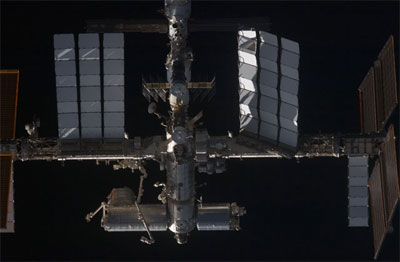Does the ISS have a future?by Taylor Dinerman
|
| Now that it is nearing completion, much of the passionate debate surrounding the ISS has dissipated. |
For the next three years ESA will have 285 million euros to spend on research onboard the ISS. The US will not only have the funds from NASA’s annual budget but, thanks to the US section’s status as a “National Laboratory”, other parts of the government as well as the private sector will be able to work there. The Japanese have an extensive plan to use their newly-attached Kibo module as well as the external platform that NASA plans to launch sometime in the fall.
If all goes well there will soon be a full crew of six astronauts and cosmonauts living and working on the station. This will more than double the amount of time that can be devoted to experiments. Previously the painfully slow process of getting anything done on the ISS gave the impression that nothing has yet been done. As the sheer volume of research piles up, it will be easier to judge just how valuable the “world class laboratory” really is.
What is truly impressive is the politics of the project. The station has now gone through four separate administrations of both parties and is now on its fifth one. The project has now been endorsed by large bipartisan majorities in both houses of Congress and the great question is no longer whether to finish building it, but how long and at what expense to keep it in operation.
Some of the key issues associated with those questions include: Is the truss structure sound, and will it stand up to long-term stresses of orbital operations? How long will the seals between the modules hold up and what kind of maintenance will they need? Will the solar arrays continue to operate at sufficient efficiency for the next decade or longer? What will it cost to replace different elements when they wear out? When the ISS can no longer be used as whole, can the different elements of the structure be recycled into a newer space station?
Right now there is no firm answer to the question of how will NASA gain access to the ISS during the “Gap” between the shuttle’s retirement and the introduction of the Orion. However, there is at least a possibility that the SpaceX Dragon capsule or perhaps something from another firm will be ready in 2012 or thereabouts. The Gap may also be reduced if the shuttle keeps flying beyond its current 2010 retirement date.
The delays that are all too common during shuttle operations have raised the possibility that there will still be unflown missions in late 2010 at the time NASA plans to retire the system. What will happen then? Will the president order that the system be retired with all that hardware still on the ground, notably the Alpha Magnetic Spectrometer (AMS), which has just been put on the manifest of an extra “last” mission? If there is going to be one—or maybe more—flights in 2011, how will they be paid for? Will there be extra money in NASA’s budget? Will it have to come out of the Constellation program’s funding, or will there be some sort of supplemental appropriation?
| Whoever the new NASA administrator is, major policy decisions for the station need to be made soon. |
The ISS is a major human accomplishment, mostly built and paid for by America. The fact that it is a symbol of international cooperation makes it more important than ever. It is one of the very few places where the US and Russia are still working harmoniously together. Neither nation sees any reason to change this. The other partners have all invested too much time and effort to see the station be abandoned prematurely.
Whoever the new NASA administrator is, major policy decisions for the station need to be made soon. Congress needs to spend some time looking at the future of the program and the major contractors should start trying to work out what they will have to do to keep it in orbit. It is time for NASA to explain to the public what has and has not been accomplished on the ISS and what have we learned from its construction.
